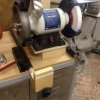Would it be acceptable to vary the prescribed sharpening technique as follows:
Using the wolverine vari-grind attachment set to 23 degrees and use a tool protrusion of 2 inches. Then use The Raptor set up tool for constant bevel angles. Should result in more constant bevel angles.
Using the wolverine vari-grind attachment set to 23 degrees and use a tool protrusion of 2 inches. Then use The Raptor set up tool for constant bevel angles. Should result in more constant bevel angles.

